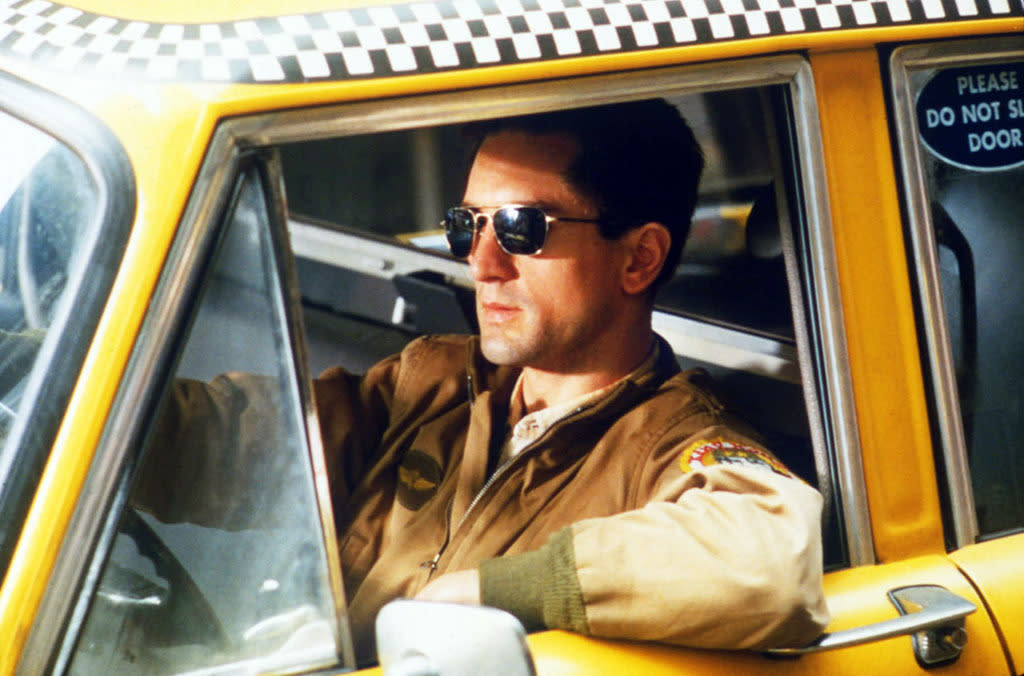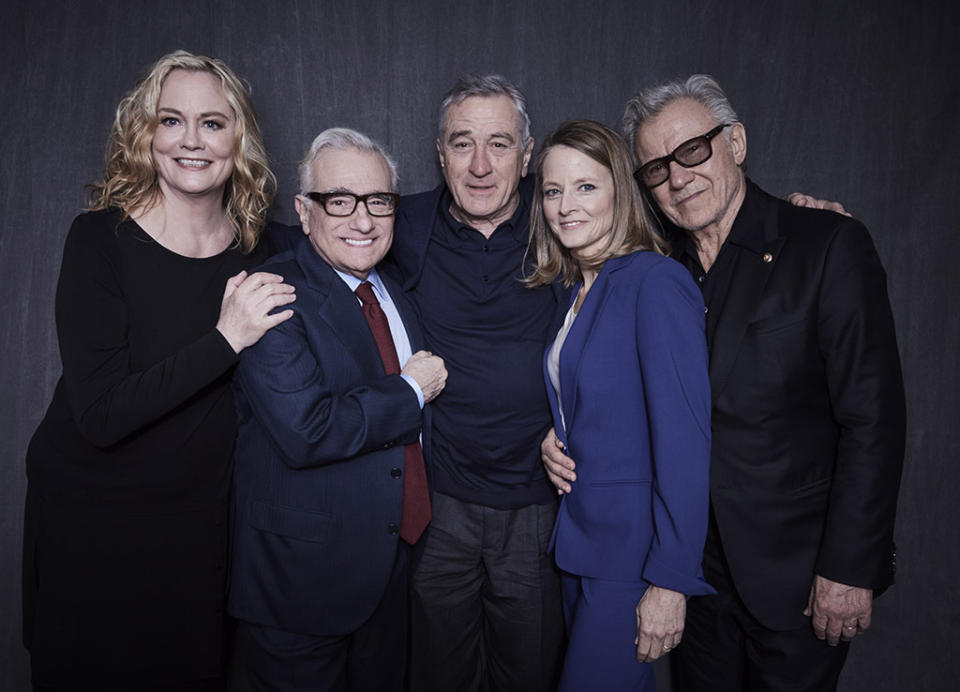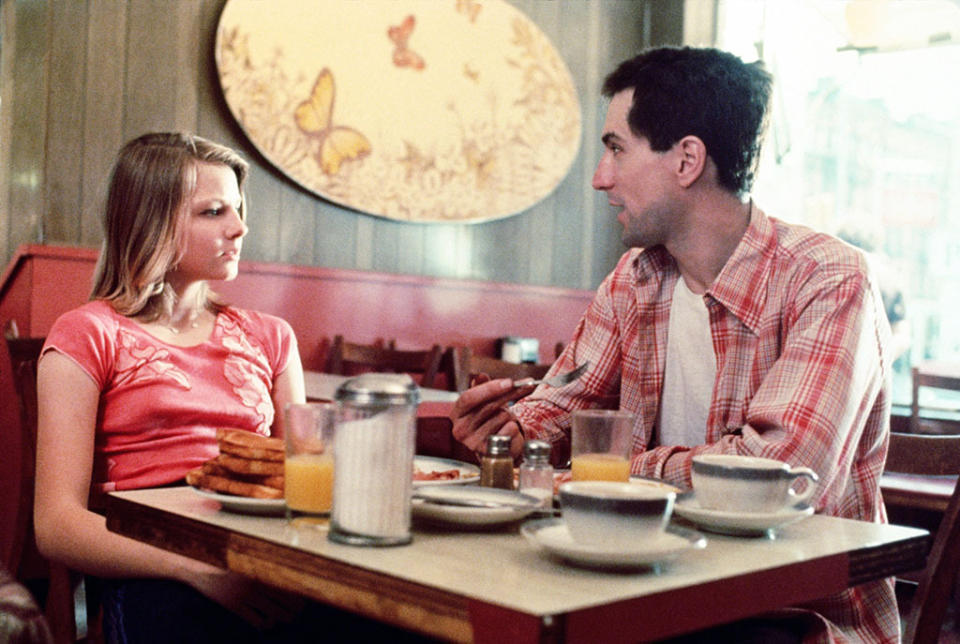The 'Taxi Driver' Cast Reunited in New York Last Night: Here's What We Learned About the Making of the Movie

Robert De Niro in ‘Taxi Driver’ (Everett)
Robert De Niro knew it was coming. Taking the stage at New York’s Beacon Theatre to introduce the Tribeca Film Festival’s 40th anniversary screening of Taxi Driver on Thursday night, he made sure to address the line on everyone’s mind. “Every day for 40 f—ing years, at least one of you has come up to me and said — what do you think —‘You talkin’ to me?’“ That phrase, of course, is one of the many highlights of Martin Scorsese’s classic portrait of alienation in ‘70s-era New York, uttered by the titular cab driver, Travis Bickle, while preening in front of a mirror. Knowing that’s the line the audience most wanted to hear, De Niro led the packed house in a mass recitation. “Thank you. Try not to laugh at that scene during the movie,” the actor said, with equal parts good humor and exasperation.
Sure enough, only a few hardy souls laughed when De Niro’s younger self asked, “You talkin’ to me?” during the film. The rest of the crowd sat immersed in Scorsese’s fever dream of a bygone New York, one in which Times Square was the opposite of tourist-friendly and signs of urban decay were visible on almost every block. We were all saving our laughter and applause for the post-screening conversation, when an all-star panel took the stage to share their memories of making the film during a blistering hot New York summer 40 years ago. Scorsese and De Niro were joined by Taxi Driver screenwriter Paul Schrader, as well as one-half of the film’s producing team, Michael Phillips (his wife and creative partner, Julia Phillips, passed away in 2002) and Jodie Foster, Cybill Shepherd and Harvey Keitel. Here are some of the highlights of that conversation.

Cybill Shepherd, Martin Scorsese, Robert De Niro, Jodie Foster and Harvey Keitel on Thursday night (Larry Busacca/Getty Images for Tribeca Film Festival)
Writing Taxi Driver Was Self-Exorcism for Schrader
Decades before he directed an actual Exorcist film, Schrader wrote Taxi Driver as a way to divest himself of an evil spirit he felt had taken hold of his body. “There was a person who I was afraid of becoming, and that was this taxi driver. I thought if I wrote about him, I could distance him from me. And it worked! [During shooting] Bob, Marty and I never talked much about the script, because we knew this guy. [We were] three young men at a certain moment in their lives who shared a common pathology.” Perhaps recognizing Travis’s connection to Schrader, De Niro modeled some of the character’s sense of style after his creator, specifically his boots and bomber jacket.
Taxi Driver Could Have Been a Brian De Palma Movie
The director of underground hits like Hi, Mom! (starring a very young De Niro) was the first filmmaker to read Schrader’s completed screenplay for Taxi Driver, which Schrader passed along to the filmmaker while writing a profile of him in 1972. While he liked the script, De Palma felt he wasn’t the right person to make it, and so he handed it off to producers Mike and Julia Phillips, who happened to be his neighbors. The script eventually found its way into Scorsese’s hands, but at that point, his filmography was too limited to land the gig. When the producers saw Scorsese’s 1973 crime drama Mean Streets, they knew they had their director and star, both of whom stuck with the project even as their careers were taking off. “Bobby had won an Oscar for The Godfather, Part II and Marty was recognized as a star director, but they hung in there at bargain basement prices,” Phillips said.
De Niro Hacked It for 10 Days
Before shooting started, De Niro demonstrated his intense commitment to the role by piloting a cab around New York for almost two weeks. While most of the city’s residents were too jaded to realize they were being chauffeured by a celebrity, one person was caught off guard. As Scorsese recalled to De Niro: “You told me that a guy got in the car, noticed your name on the driver’s license and said, ‘My God, you just won an Oscar! Is it that hard to get jobs?’”

Foster and De Niro in ‘Taxi Driver’ (Everett)
Big Pimpin’
Scorsese originally offered his Mean Streets star Harvey Keitel the role of the nerdy campaign worker that Albert Brooks eventually played. But Keitel was dead-set on playing Sport, the pimp who keeps a close eye on Foster’s child prostitute, Iris. There was just one problem: The actor didn’t know the first thing about being a pimp. “I was in a Broadway show at the time, and a lot of the girls would hang out on 9th and 10th Avenue. One night, I went up to one of the girls and said, ‘Excuse me, my name is Harvey Keitel and I’m doing a movie.’ I explained to her about playing a pimp and asked if she could help me out. She looks at me and goes, ‘No one’s going to talk to you!’” Eventually, Keitel did connect with a pimp, who told him about the ins and outs of the business. “I would play the girl, and he would tell me what it was like to play the role of the pimp. We had a good business together!”
Foster’s Age Raised a Ruckus
After a successful career as a Disney child star, Foster felt an urge to pursue more grown-up material, and was encouraged to do so by her mother, who was eager for her daughter to have a “meaningful career.” Not everyone proved so open-minded, though. According to Foster, California’s Board of Education declined to issue her a work permit to make Taxi Driver, requiring her family to retain a lawyer. Eventually, the board acquiesced, provided that Foster submit to a lengthy psychological examination. And the interference didn’t end there. For the movie’s bloody climax, the crew had to spend three months ripping out the ceiling so that Scorsese could film that famous overhead tracking shot presenting the carnage of Travis’s shooting spree. “When it came time to shoot that scene, the child labor law person told us we only had 20 minutes,” Scorsese remembers. “We kept begging for more time, [but] we got it in two takes.”
De Niro’s Mohawk Is Movie Magic
De Niro and Scorsese remembered that they modeled Travis’s late movie Mohawk look after a mutual friend who served in the Special Forces during the Vietnam War. Because the actor had to go straight into another film — the period piece, The Last Tycoon — right after Taxi Driver wrapped, he was concerned about giving himself such an extreme makeover. So the film’s makeup artist, Dick Smith, came up with a hairpiece that looks even more unnerving than the real thing. It certainly worked for Scorsese. “I remember I had fallen asleep while Bob was getting the headpiece on. I felt a tap on my shoulder, and I look up and there’s this thing! It was terrifying.”
Watch a trailer for ‘Taxi Driver:’
Bernard Herrmann Was a Real Character
Before Taxi Driver, Scorsese made a point of integrating existing music into his films, such as the blast of the Ronettes “Be My Baby” during the opening credits of Mean Streets. But early on, he realized something important about Travis. “He doesn’t listen to any music! The only person who could express what he’s [feeling] was Bernard Herrmann.” So Scorsese personally sought out the legendary film composer behind such scores as Citizen Kane and Psycho, who at that point was living in semi-retirement in London. “I told him, ‘I would like you to take a look at this script: It’s called Taxi Driver.’ And he said, ‘I don’t do films about cabbies!’”
When he finally did read the script, he instantly responded to the main character. (According to Scorsese, Herrmann’s favorite detail about Travis was that he mixed his cereal with peach brandy.) Taxi Driver proved to be his last completed job as a composer; he passed away in 1975 after wrapping his second and final day of work recording the soundtrack. His last act was to come up with a sting for the final shot of the film, where Travis gazes quickly into his rearview mirror. “He went to the xylophone and hit it a number of times, and said, ‘Play it back.’ I did and said, ‘I need something special.’ And he said, ‘Play it backwards,’ and walked out. Last time I saw him,” said Scorsese.


